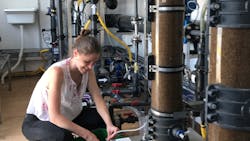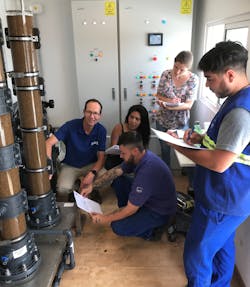Arsenic challenge unites water teams in Netherlands, Argentina
Water treatment experts from the Netherlands and Argentina are uniting to help find a sustainable solution to remove arsenic from groundwater.
Naturally-occurring arsenic, has been found in high concentrations in several parts of Argentina. To solve the issue, two pilot projects are underway between Argentina’s major water utility Agua y Saneamientos Argentinos S.A. (AySA) and partners Royal HaskoningDHV, TRAIDE, and KWR Water Research Institute (KWR), with support of the Embassy of the Netherlands in Buenos Aires.
As part of the two-and-a-half-year Low Energy Arsenic Free (LEAF) project, an initiative took place over three months at the Ezeiza water treatment plant. KWR developed the project set up, designed pilots, and defined the research. Work was carried out by the AySA research team in close cooperation with KWR.
One pilot is based on co-precipitation followed by rapid sand filtration (C-RSF), and the other on co-precipitation followed by ultrafiltration (C-UF).
Going Above WHO Arsenic Limits
The pilot projects in Argentina showed positive results during the first three months of implementation, reducing arsenic levels in the treated groundwater down to 10 micrograms per liter and lower, complying with the outlet concentration with Argentine regulations. Furthermore, significant energy and chemical savings were achieved.
Although the results obtained are encouraging, a longer period is required to draw conclusive conclusions.
“Many of the existing technologies, such as reverse osmosis membranes or absorption processes use a lot of energy and chemicals, respectively, and operational costs can be high,” says Ron Jong, a senior water treatment specialist and researcher from KWR. “We apply this process in the Netherlands but, as there’s already iron in the water, it works naturally. In Argentina, as the water is iron-free, this iron has to be added.”
By correctly dosing, the arsenic connects to the iron in the water as iron flocs, which can then be removed either using the sand filtration or ultrafiltration.
Jong believes the partnership will eventually help to disseminate knowledge and solutions to other parts of the world, with Argentina acting as a gateway into Latin America.
“Many other countries in Europe and the rest of the world have arsenic problems seriously affecting drinking water safety. For example, Bangladesh and Serbia, as well.”
Modifying Existing Processes
KWR says that, if AySA’s current adsorption processes are modified to the co-precipitation rapid sand filtration set-up, these costs would be recuperated in relatively short time.
“After proving that arsenic can be removed at the location, we’re looking at adapting the process circumstances to apply it at the bigger water treatment plants,” Jong says. “This will further evaluate and test the ability to modify and operate the process, at a larger scale.”
He says that the challenge of processing the by-product remains with scaling the process in Argentina.
“Waste liquid streams from the current absorption processes can be disposed of into surface waters. However, the waste stream from this new process is an iron sludge containing arsenic. As questions remain over the potential and reuse options in Argentina, this will require further research.”

